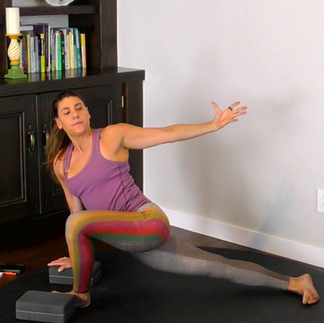There are several exercises that can help yoga students improve their ability to step forward into a low lunge from a downward-facing dog.
The basic transition goes like this: Starting in a downward-facing dog.
Inhale as you lift your right leg high into a three-legged dog (and to get more height, come onto the toes of the left foot).
Exhale as you draw the right knee toward your chest (Hug the knee actively and round the upper back to create more space to step through). At this point, you want a hollowing-out effect of the core body. Continuing to move the right foot on the inside of your right hand into a low lunge.
If you have stepped through completely your right knee will be over your right ankle, and your feet will have their own lanes (think train tracks rather than a tight rope alignment). If you come up short, you will need to use your right hand to assist in bringing the foot into proper alignment with your knee. Essentially, stacking joints - knee over ankle.
Now visualize this transition as you lightly float your foot through to low lunge. This transition takes one full breath but there is a lot that needs to happen in order for this to be seamless.
Lets break it down and explore what needs to happen.
1. Protraction of the shoulder blades and shoulder blade mobility. (protraction is pushing into the ground and puffing up the upper back of your heart to the ceiling) Exercises: cat and cow asanas, plank-cat, shoulder mobility and flexibility work.
2. Core engagement and achieving the hollowing out of the belly as you actively draw your knee into your chest. Exercises: Knee to nose practice from downward facing dog an hollow boat pose on your back- single leg and both legs mimics this action and brings awareness to the core engagement needed, hovering table top and knee to nose engagement.
3. Compression of the torso to the knee. Why? The tighter you can get your knee to your chest the more space you will have to step through into low lunge. Exercise: Ragdoll variation (chest to thigh bone compression)
4. Posterior chain (back of the spine and legs) flexibility. The Hamstrings and the spine. (unlocking will create proper engagement for your step through) Exercise: Standing forward fold-Ragdoll, half splits, pyramid, , wide leg forward fold, Legs up imaginary wall, crescent moon
5. Hip flexibility and strength. Exercises: wide knee extended Childs pose with shoulder stretch, fallen lizard (half pigeon and deer pose)
6. Quadricep flexibility. Tight quads can limit the amount of bend you can get in your knee as again to create the space required to bring your foot through to low lunge. Exercise: Hero pose, camel variation
Exercises above are demonstrated in the video attached.
Identify the areas from 1-6 where you feel you need the most work and focus on those areas. In addition to 1-6 we will work on the technique of this transition.
This 30 minute video uses blocks and exercises in the 6 areas to create awareness of your current abilities to step through to low lunge.
* If you currently are able to step through to low lunge without too much difficulty then this practice will work on elevating your step through to a straight leg position.

































Comments